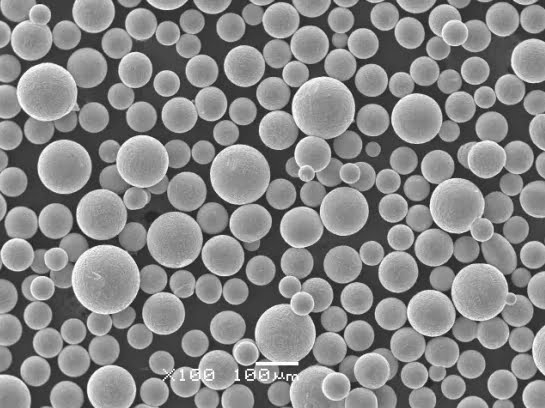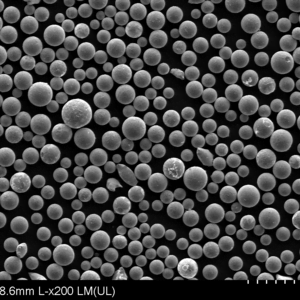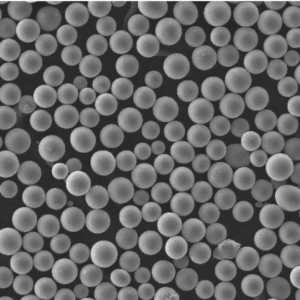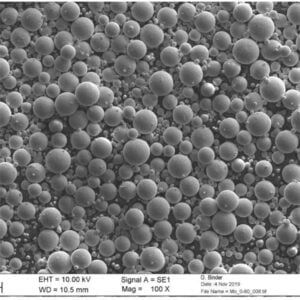300M rostfritt stål pulver
300M rostfritt stålpulver är ett specialiserat material som används inom pulvermetallurgi och additiv tillverkning. Detta höglegerade austenitiska rostfria stål uppvisar utmärkt korrosionsbeständighet och höghållfasthetsegenskaper.
300M-pulver kan användas för att skapa komplexa metallkomponenter med hjälp av avancerade tillverkningstekniker som Selektiv lasersintring (SLS), direkt metallasersintring (DMLS) och bindemedelsjetting. De fina sfäriska pulvren sprids lätt och sintras jämnt, vilket ger täta detaljer.
Låg MOQ
Tillhandahålla låg minsta orderkvantitet för att möta olika behov.
OEM & ODM
Tillhandahålla kundanpassade produkter och designtjänster för att tillgodose unika kundbehov.
Tillräckligt lager
Säkerställa snabb orderhantering och tillhandahålla tillförlitlig och effektiv service.
Kundtillfredsställelse
Tillhandahålla högkvalitativa produkter med kundnöjdhet i fokus.
dela denna produkt
Innehållsförteckning
300M har en hög nickel- och kromhalt vilket ger den utmärkt korrosionsbeständighet jämförbar med 304 och 316 rostfritt stål. Sammansättningen kontrolleras inom snäva intervall enligt nedan:
300M rostfritt stål pulver sammansättning
| Element | Sammansättning Range |
|---|---|
| Kol (C) | 0,05% max |
| Kisel (Si) | 1,0% max |
| Mangan (Mn) | 2,0% max |
| Fosfor (P) | 0,03% max |
| Svavel (S) | 0,01% max |
| Krom (Cr) | 24.0-26.0% |
| Nickel (Ni) | 19.0-22.0% |
| Molybden (Mo) | 4.0-5.0% |
| Kväve (N) | 0.10-0.16% |
| Järn (Fe) | Balans |
De viktigaste legeringselementen som krom, nickel och molybden ger rostfritt 300M dess unika egenskaper. Den höga kromhalten ger utmärkt korrosions- och oxidationsbeständighet. Nickel förstärker detta ytterligare genom att göra stålet mer motståndskraftigt mot reducerande syror. Molybden förbättrar motståndskraften mot grop- och spaltkorrosion i klorider.
Kväve tillsätts också för att stabilisera den austenitiska strukturen och öka hållfastheten genom solid lösningsförstärkning. Kolhalten är begränsad för att minimera karbidutfällning. Slutresultatet är ett mångsidigt korrosionsbeständigt stålpulver som är idealiskt för additiv tillverkning.
Egenskaper för pulver av rostfritt stål 300M
300M rostfritt stål ger en utmärkt kombination av hög hållfasthet och god duktilitet tillsammans med enastående korrosionsbeständighet. Några viktiga egenskaper beskrivs nedan:
Egenskaper för pulver av rostfritt stål 300M
| Fastighet | Värde |
|---|---|
| Täthet | 7,9 g/cm3 |
| Smältpunkt | 1370°C (2500°F) |
| Termisk konduktivitet | 12 W/m-K |
| Elektrisk resistivitet | 72 μΩ-cm |
| Elasticitetsmodul | 200 GPa |
| Poissonförhållande | 0.29 |
| Draghållfasthet | 165 ksi (1140 MPa) |
| Utbyteshållfasthet | 140 ksi (965 MPa) |
| Töjning | 35% |
Den austenitiska strukturen ger 300M förbättrad seghet och duktilitet jämfört med martensitiska stålsorter. Den gör också stålet icke-magnetiskt. Materialet har god hållfasthet upp till 600°C och kan användas vid kryogena temperaturer. Korrosionsbeständigheten är jämförbar med 316L. Slitstyrkan är lägre än för martensitiska stålsorter men bearbetbarheten är utmärkt.
Sammantaget erbjuder 300M en exceptionell balans mellan styrka, duktilitet, brottseghet och korrosionsbeständighet, vilket gör den lämplig för krävande applikationer inom additiv tillverkning i branscher som flyg, kemisk bearbetning, olja & gas etc.
300M rostfritt stål pulverapplikationer
Några typiska användningsområden och applikationer för 300M rostfritt stålpulver inkluderar:
300M rostfritt stål pulverapplikationer
| Industri | Vanliga tillämpningar |
|---|---|
| Flyg- och rymdindustrin | Motorkomponenter, strukturella delar, landningsställ |
| Fordon | Ventilhus, pumpdelar, komponenter till turboladdare |
| Medicinsk | Implantat, proteser, kirurgiska instrument |
| Kemisk | Pumpar, ventiler, rördelar |
| Olja & Gas | Borrhålsverktyg, delar till borrhålshuvud, offshorekomponenter |
| Industriell | Utrustning för livsmedelsbearbetning, pressplattor, matriser och formar |
| Konsument | Klockfodral, smycken, dekorativa konstföremål |
Den utmärkta korrosionsbeständigheten gör att 300M klarar tuffa driftsmiljöer i branscher som olja & gas, kemisk bearbetning, rening av föroreningar etc. där delar utsätts för syror, alkalier, salter eller klorider.
I flyg- och rymdtillämpningar ger den hög hållfasthet för viktbesparing i kombination med god kryp- och utmattningshållfasthet vid förhöjda temperaturer. Den austenitiska strukturen ger utmärkt brottseghet.
För medicinsk användning som implantat och kirurgiska verktyg är den goda biokompatibiliteten och höga hållfastheten hos 300M rostfritt fördelaktig. För konsumentprodukter gör det attraktiva utseendet och möjligheten att polera till spegelfinish det lämpligt för dekorativa tillämpningar.
Additiv tillverkning gör det möjligt att tillverka komponenter med komplexa geometrier och invändiga egenskaper som inte är möjliga med konventionella tillverkningsmetoder. Detta utökar designfriheten och användningsområdena för 300M rostfritt stålpulver.
300M rostfritt stålpulver Specifikationer
300M-pulver finns kommersiellt tillgängligt i olika storleksintervall, morfologier och blandningar som är skräddarsydda för olika additiva tillverkningsprocesser. Några viktiga specifikationer anges nedan:
300M rostfritt stålpulver Specifikationer
| Parameter | Typiska värden |
|---|---|
| Partikelns form | Sfärisk, satellit, oregelbunden |
| Partikelstorlek | 15-45 μm, 15-53 μm, 53-150 μm |
| Skenbar densitet | 2,5-4,5 g/cm3 |
| Tappdensitet | 3,5-4,5 g/cm3 |
| Flödeshastighet | 15-25 s/50g |
| Kolinnehåll | < 0,05 wt% |
| Syrehalt | < 0,15 wt% |
| Kväveinnehåll | 0,10-0,16 wt% |
| Innehåll av väte | < 0,0015 wt% |
- Sfäriska pulver sprids lätt och har god flytbarhet för jämn skiktdeponering. De är idealiska för SLS/DMLS-processer.
- Oregelbundna och satellitformade morfologier ger bättre packningstäthet för bindemedelssprutning.
- Mindre partikelstorlekar (~20 μm) är att föredra för bättre upplösning och ytfinish.
- Större storlekar (~45-150 μm) förbättrar pulverflödet och minskar risken för att ommålaren fastnar.
-kemi, särskilt för interstitiella element som C, N, O, H, kontrolleras för att undvika förångning och porositetsproblem under tryckningen.
Gaser som kväve och argon kan användas under finfördelningen för att minimera oxidation och väteupptagning. Legeringselementen justeras för att kompensera för ångförluster under bearbetningen.
300M rostfritt stålpulver leverantörer
300M-pulver erbjuds av flera ledande leverantörer av material för additiv tillverkning av metall:
300M rostfritt stålpulver leverantörer
| Företag | Varumärken | Tillgängliga partikelstorlekar |
|---|---|---|
| Sandvik | Osprey 300M | 15-45 μm, 53-150 μm |
| Snickare Tillsats | 300M-18, 300M-28 | 15-53 μm |
| Praxair | TruForm 300M | 15-45 μm |
| SLM-lösningar | 300M | 15-45 μm |
| EOS | RostfrittSteel 300M | 20-50 μm |
| LPW-teknik | LF300M | 15-45 μm |
De största pulvertillverkarna använder gasatomisering för att framställa sfäriskt 300M-pulver som lämpar sig för fusionsprocesser med laserpulverbädd, t.ex. selektiv lasersmältning (SLM) och direkt metallsintring (DMLS).
Andra nischleverantörer erbjuder vatten- och plasmaatomiserat 300M-pulver med mer oregelbundna morfologier till lägre kostnader. Dessa är inriktade på applikationer för bindemedelssprutning.
Sammantaget finns 300M-pulver lätt tillgängligt globalt från leverantörer av AM-material i metall, vilket säkerställer en tillförlitlig leveranskedja för slutanvändarna.
300M Rostfritt stål Pulver Kostnader
300M-pulver är dyrare än mer vanliga kvaliteter som 316L rostfritt på grund av dess specialiserade sammansättning som innehåller mycket nickel, krom och molybden. Några typiska prisintervall visas nedan:
300M Rostfritt stål Pulver Kostnader
| Pulverkvalitet | Morfologi | Prisintervall |
|---|---|---|
| 300 miljoner förlegerade | Sfärisk | $60-100 per kg |
| 300M vattenatomiserad | Oregelbunden | $30-60 per kg |
- Förlegerade sfäriska pulver som tillverkas genom gasatomisering är dyrare på grund av högre produktionskostnader och bättre kvalitet.
- Vattenatomiserade eller plasmaatomiserade irreguljära pulver är billigare men har högre syrehalt.
- Större partikelstorlekar (>45 μm) har lägre priser på grund av högre utbyte under tillverkningen.
- Mindre kvantiteter och anpassade blandningar är dyrare. Bulkbeställningar kan förhandla fram bättre priser.
- Blandade elementpulver kan ge kostnadsbesparingar men har lägre prestanda än förlegeringar.
- Återvunnet pulver är ~20-30% billigare men har begränsad återanvändning.
Totalt kostar 300M-pulver $30-100 per kg baserat på kvalitet, morfologi, storleksintervall, ordervolymer och leverantörspriser. Kostnaderna sjunker i takt med ökad konkurrens och framsteg inom finfördelningstekniken.
300M rostfritt stål Pulverhantering
300M-pulver ska hanteras med försiktighet för att undvika kontaminering eller blandning med andra material. Några riktlinjer ges nedan:
300M rostfritt stål Pulverhantering
- Förvara oöppnade behållare i en torr, inert miljö för att förhindra oxidation och fuktupptagning
- Öppna behållare i handskboxar fyllda med argon för att förhindra luftexponering
- Använd verktyg och behållare som endast är avsedda för 300M för att förhindra korskontaminering
- Undvik kontakt med järn eller kol för att förhindra förändringar i sammansättningen
- Mät pulvervikten noggrant före återanvändning för att kontrollera blandningsförhållandena
- Sikta pulver före återanvändning för att bryta upp agglomerat och avlägsna stora partiklar
- Häll inte tillbaka pulvret direkt i huvudbehållaren för att förhindra att nytt och använt pulver blandas
- Rengör utrustningen noggrant mellan hantering av batcher för att förhindra korskontaminering
Korrekt hantering och förvaring bidrar till att bibehålla pulversammansättning, morfologi, flytbarhet och återanvändningsegenskaper. Kontaminering kan påverka materialegenskaperna negativt eller orsaka tryckfel.
300M rostfritt stål Pulverförvaring
300M-pulver ska förvaras under följande förhållanden:
300M rostfritt stål Pulverförvaring
- Förvaras i originalförslutna förpackningar tills de är klara att användas
- Använd inert gasförsegling eller vakuumförpackning för långtidsförvaring
- Förvaras svalt, torrt och skyddat från direkt solljus
- Omgivningstemperaturer mellan 10-25°C är idealiska för förvaring
- Undvik temperaturväxlingar och luftfuktighet som kan orsaka kondens
- Använd torkpåsar när du öppnar behållare för att absorbera fukt
- Begränsa lagringstiden till 6-12 månader för förlegerade pulver för att undvika oxidation
- Rotera lagret med hjälp av FIFO-systemet (först in, först ut)
Korrekt förvaring är avgörande för att förhindra att pulvret försämras över tid av fukt, syre eller andra miljöfaktorer. Följ tillverkarens rekommendationer för maximal hållbarhet.
300M rostfritt stål pulver säkerhet
300M-pulver kräver samma försiktighetsåtgärder vid hantering som andra fina pulver av rostfritt stål:
300M rostfritt stål pulver säkerhet
- Använd lämplig personlig skyddsutrustning vid hantering - handskar, andningsskydd, ögonskydd
- Undvik att andas in pulverformigt damm - använd ventilation och masker
- Undvik hudkontakt för att förhindra sensibilisering - använd handskar
- Använd gnistsäkra verktyg och dammsugarsystem som är avsedda för brännbart damm
- Handskboxar för inerta gaser ger skydd vid hantering
- Explosionssäker belysning och elektrisk utrustning rekommenderas
- Följ säkerhetsföreskrifterna i säkerhetsdatabladet och använd personlig skyddsutrustning under bearbetning
- Håll rent för att undvika ansamling av partiklar och minimera riskerna
- Använd dammuppsamlingssystem och rutiner för hushållsarbete för att minska riskerna med brännbart damm
Finfördelade pulver medför risker som sensibilisering vid långvarig exponering och explosionsrisker vid ansamling av damm. Medvetenhet, utbildning och säkra rutiner är avgörande.
300M rostfritt stål Pulvertryck
300M kräver optimerade tryckparametrar som är skräddarsydda för legeringen:
300M rostfritt stål Tryckparametrar
- Lasereffekt/energitäthet: 150-220 W, 50-90 J/mm3
- Skanningshastigheter: 600-1200 mm/s
- Avstånd mellan luckorna: 80-120 μm
- Skikttjocklek: 20-50 μm
- Argon för motflöde är att föredra framför kväve
- Syrenivåer under 1000 ppm förhindrar oxidation
- Förvärmning till 80-150°C minskar restspänningar
- Stressavlastande värmebehandlingar obligatoriska för att förhindra sprickbildning
Viktiga faktorer är att minimera termiska påfrestningar och undvika problem med varmsprickor för att uppnå utskrifter med hög densitet. En viss grad av parameterjustering krävs för att optimera för specifika skrivarmodeller.
300M rostfritt stål pulver efterbearbetning
Typiska metoder för efterbearbetning av 300M-delar är
300M rostfritt stål Del efterbearbetning
- Borttagning av stöd med EDM eller sandblästring
- Spänningsavlastning vid 1065-1120°C i 1-2 timmar för att förhindra sprickbildning
- Varm isostatisk pressning (HIP) för att eliminera inre hålrum och förbättra utmattningshållfastheten
- Värmebehandling vid 900-950°C för att justera hårdhet/hållfasthet
- Slipning, blästring, slipning, polering för att förbättra ytfinishen
- Passivering i salpetersyra för att avlägsna värmefärg och förbättra korrosionsbeständigheten
- Shot peening för att framkalla tryckspänningar och förbättra utmattningslivslängden
- Ytbeläggningar som PVD, CVD kan ge slitstyrka/korrosionsbeständighet eller unika utseenden
Efterbehandling i flera steg är ofta nödvändig för att uppnå önskade materialegenskaper, måttnoggrannhet, ytkvalitet och estetik. Processen beror på applikationskraven.
300M rostfritt stål pulver kvalitetskontroll
Omfattande tester bör utföras för att säkerställa kvaliteten på pulver och tryckta delar:
300M rostfritt stål pulverprovning
| Test | Detaljer |
|---|---|
| Kemisk analys | ICP-OES, ICP-MS, våtkemi, spark OES |
| Fördelning av partikelstorlek | Laserdiffraktion, siktanalys |
| Morfologi | SEM-avbildning, mikroskopi |
| Pulverdensitet | Scott volymmätare, Hall flödesmätare |
| Flödeshastighet | Hall-flödesmätare |
| Fuktanalys | Termogravimetrisk analys |
300M rostfritt stål Delprovning
| Test | Detaljer |
|---|---|
| Täthet | Arkimedes, Helium-pyknometri |
| Ytjämnhet | Profilometer, interferometri |
| Hårdhet | Rockwell, Vickers, Brinell |
| Draghållfasthet | ASTM E8 |
| Mikrostruktur | Optisk mikroskopi, bildanalys |
| Bindning av lager | Elektronmikroskopi, färgpenetrant |
| Porositet | Röntgentomografi, bildanalys |
| Ytliga defekter | Penetranttestning, mikroskopi |
Omfattande tester enligt industristandarder säkerställer jämn pulverkvalitet och prestanda för tryckta detaljer. Det minimerar defekter och förhindrar att delar går sönder under drift.
Fördelar med 300M rostfritt stålpulver
Några av fördelarna med att använda 300M-pulver för additiv tillverkning är
- Utmärkt korrosionsbeständighet jämförbar med rostfritt stål 316L
- Hög hållfasthet med god duktilitet och brottseghet
- Kan enkelt bearbetas med laserpulverbäddsfusion, bindemedelsstrålning etc.
- God måttnoggrannhet och ytfinhet i tryckta delar
- Fungerar bra i tuffa miljöer och vid förhöjda temperaturer
- Kan producera komplexa geometrier som inte är möjliga med konventionella metoder
- Delarna kan värmebehandlas för att skräddarsy egenskaper som hårdhet, hållfasthet etc.
- Erbjuder designflexibilitet som inte begränsas av typiska tillverkningsbegränsningar
- Sparar material, energi och kostnader jämfört med subtraktiva metoder
- Finns i stor utsträckning hos ledande leverantörer för att säkerställa tillförlitlig materialförsörjning
Kombinationen av enastående materialegenskaper, avancerad tillverkningsbarhet och anpassningsbarhet gör 300M till en idealisk legering för verksamhetskritiska AM-komponenter i olika branscher.
Begränsningar för pulver av rostfritt stål 300M
300M har också vissa begränsningar att ta hänsyn till:
- Dyrare än vanliga legeringar som 316L eller 17-4PH rostfritt
- Kräver optimerade bearbetningsparametrar som är skräddarsydda för legeringen
- Känslig för kontaminering från felaktig pulverhantering
- Behov av varm isostatisk pressning (HIP) för att eliminera inre hålrum
- Lägre slitstyrka än martensitiska rostfria stålpulver
- Kräver efterbearbetning och ytbehandling
- Höga termiska spänningar kan orsaka sprickbildning; värmebehandlingar obligatoriska
- Oxidation och kväveabsorption kan förekomma under bearbetningen
- Delarna kan behöva stöd för att undvika deformation under tryckningen
- Begränsat antal leverantörer jämfört med mer vanliga legeringar
Den speciella sammansättningen, den höga kostnaden och behovet av kontrollerade bearbetningsförhållanden begränsar användningen till kritiska applikationer där prestandan motiverar den högre kostnaden.
300M vs 316L vs 17-4PH Pulver av rostfritt stål
Hur står sig 300M i jämförelse med andra populära rostfria stålpulver som 316L och 17-4PH?
Jämförelse av pulver av rostfritt stål
| Legering | Sammansättning | Fastigheter | Tillämpningar |
|---|---|---|---|
| 300M | Hög Ni, Cr, Mo | Utmärkt korrosionsbeständighet, god duktilitet och seghet, hög hållfasthet till 600°C | Flyg, olja & gas, kemi, högtemperaturanvändning |
| 316L | Medium Ni, Cr | Utmärkt korrosionsbeständighet, lätt svetsbar, god biokompatibilitet | Marin utrustning, medicinska implantat, livsmedelsbearbetning |
| 17-4PH | Medel Ni, Cr + Cu | Hög hårdhet och hållfasthet, god korrosionsbeständighet, värmebehandlingsbar | Flyg- och rymdindustrin, verktyg, fordonsindustrin, plastformar |
300M ger den bästa kombinationen av korrosionsbeständighet och användbar styrka vid förhöjda temperaturer. 17-4PH är att föredra för applikationer
300M rostfritt stålpulver är ett specialiserat material som används inom pulvermetallurgi och additiv tillverkning. Detta höglegerade austenitiska rostfria stål uppvisar utmärkt korrosionsbeständighet och höghållfasthetsegenskaper.
300M-pulver kan användas för att skapa komplexa metallkomponenter med hjälp av avancerade tillverkningstekniker som selektiv lasersintring (SLS), direkt metalllasersintring (DMLS) och bindemedelsjetting. De fina sfäriska pulvren sprider sig lätt och sintrar jämnt, vilket ger täta detaljer.
Här finns mer innehåll som fortsätter jämförelsen mellan pulver av rostfritt stål 300M, 316L och 17-4PH:
Detaljerad jämförelse
- 300M har högre draghållfasthet än 316L och lägre duktilitet. Den bibehåller hållfastheten upp till 600°C bättre än 316L.
- 316L har den bästa allroundkorrosionsbeständigheten följt av 300M och 17-4PH. 300M motstår grop- och spaltkorrosion bättre än 316L.
- 17-4PH uppnår den högsta hårdheten efter värmebehandling men har lägre seghet än 300M och 316L.
- 300M har högre nickelhalt än 316L och 17-4PH vilket förbättrar korrosionsbeständigheten. 17-4PH innehåller koppar för utskiljningshärdning.
- 300M används i specialiserade applikationer som kräver hållfasthet vid förhöjda temperaturer, t.ex. komponenter inom flyg- och rymdindustrin. 316L används ofta i korrosiva miljöer i branscher där hög hållfasthet inte är avgörande.
- 17-4PH passar applikationer som kräver hög hårdhet, t.ex. formar, verktyg och slitstarka delar för fordons- och konsumentanvändning.
- 300M- och 17-4PH-pulver är dyrare än vanligt 316L-pulver. 17-4PH är relativt lättare att bearbeta genom lasersintring än 300M.
- Alla tre är lätt svetsbara kvaliteter i glödgat/lösgjort tillstånd. 17-4PH kräver åldringsbehandling efter svetsning för att återställa egenskaperna.
- 300M kräver spänningsavlastande värmebehandling efter tryckning för att förhindra sprickbildning. 17-4PH värmebehandlas normalt med H900 efter tillverkningen för optimala egenskaper.
Sammanfattningsvis fyller 300M en nisch mellan den generella korrosionsbeständigheten hos 316L och den höga hållfastheten/hårdheten hos martensitisk 17-4PH. Det ger de bästa egenskaperna vid förhöjd temperatur, vilket är avgörande för flyg- och rymdtillämpningar.
300M Rostfritt stål Pulver Frågor
Här är några vanliga frågor som ställs om 300M rostfritt stålpulver:
300M rostfritt stål pulver FAQ
F: Vilken partikelstorlek är bäst för tryckning av 300M rostfritt stål?
S: 15-45 mikrometer rekommenderas för SLM/DMLS. Större storlekar 45-100 mikrometer förbättrar flytbarheten men minskar upplösningen.
F: Vad är den typiska densiteten som uppnås för 300M delar som skrivs ut med laserpulverbäddfusion?
S: Tryckt densitet över 99% kan uppnås med optimerade parametrar. HIP hjälper till att eliminera interna hålrum.
F: Vad är den typiska ytjämnheten för tryckta 300M-delar?
A: Cirka 10-15 mikrometer Ra-ytjämnhet är typiskt, vilket kan minskas till under 1 mikrometer genom polering.
F: Kräver 300M några värmebehandlingar efter bearbetning?
Svar: Ja, avspänning vid 1065-1120°C för att förhindra sprickbildning följt av kylning vid <50°C/timme rekommenderas.
Q: Vilka är några typiska användningsområden för binderjet-tryckta 300M-detaljer?
A: Verktygskomponenter, jiggar, fixturer, formar för plastinsprutning är vanliga applikationer som drar nytta av hårdheten och korrosionsbeständigheten.
F: Hur ska oanvänt 300M-pulver förvaras för återanvändning?
A: I en torr, inert atmosfär försluten behållare vid 10-25°C i upp till 1 år. Förvaras åtskilt från järnföroreningar.
F: Kan man värmebehandla 300M för att öka dess hårdhet?
S: Ja, åldring vid 900-950°C kan öka hårdheten upp till 38 HRC på liknande sätt som utskiljningshärdning.
Detta täcker några viktiga frågor om 300M-pulver. Kontakta oss gärna om du har några andra specifika frågor.
Slutsats
Sammanfattningsvis ger 300M rostfritt stålpulver en exceptionell kombination av hög hållfasthet, god duktilitet, utmärkta egenskaper vid förhöjd temperatur och korrosionsbeständighet som inte överträffas av andra legeringar. Det är idealiskt för kritiska komponenter inom flyg-, olje- och gasindustrin samt den kemiska industrin som trycks med de senaste additiva tillverkningsteknikerna.
För att uppnå optimala materialegenskaper måste man vara försiktig vid lagring, hantering och bearbetning. Testning och kvalitetskontroll är också viktigt i alla steg. De högre kostnaderna begränsar användningen till nischapplikationer där prestandan motiverar prispremien jämfört med vanliga legeringar.
Med ökad mognad inom AM-tekniken och framtida kostnadsminskningar kommer speciallegeringar som 300M att få ökad användning i olika branscher som vill dra nytta av deras unika egenskaper och anpassa komponenter för maximal prestanda.
Få det senaste priset
Om Met3DP
Produktkategori
HOT SALE
KONTAKTA OSS
Har du några frågor? Skicka oss meddelande nu! Vi kommer att betjäna din begäran med ett helt team efter att ha fått ditt meddelande.

Metallpulver för 3D-printing och additiv tillverkning
FÖRETAG
PRODUKT
cONTACT INFO
- Qingdao City, Shandong, Kina
- [email protected]
- [email protected]
- +86 19116340731













